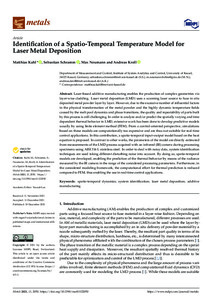| dc.date.accessioned | 2022-05-03T08:55:56Z | |
| dc.date.available | 2022-05-03T08:55:56Z | |
| dc.date.issued | 2021-12-18 | |
| dc.identifier | doi:10.17170/kobra-202205036123 | |
| dc.identifier.uri | http://hdl.handle.net/123456789/13805 | |
| dc.description.sponsorship | Gefördert durch den Publikationsfonds der Universität Kassel | |
| dc.language.iso | eng | |
| dc.rights | Namensnennung 4.0 International | * |
| dc.rights.uri | http://creativecommons.org/licenses/by/4.0/ | * |
| dc.subject | spatio-temporal dynamics | eng |
| dc.subject | system identification | eng |
| dc.subject | laser metal deposition | eng |
| dc.subject | additive manufacturing | eng |
| dc.subject.ddc | 620 | |
| dc.title | Identification of a Spatio-Temporal Temperature Model for Laser Metal Deposition | eng |
| dc.type | Aufsatz | |
| dcterms.abstract | Laser-based additive manufacturing enables the production of complex geometries via layer-wise cladding. Laser metal deposition (LMD) uses a scanning laser source to fuse in situ deposited metal powder layer by layer. However, due to the excessive number of influential factors in the physical transformation of the metal powder and the highly dynamic temperature fields caused by the melt pool dynamics and phase transitions, the quality and repeatability of parts built by this process is still challenging. In order to analyze and/or predict the spatially varying and time dependent thermal behavior in LMD, extensive work has been done to develop predictive models usually by using finite element method (FEM). From a control-oriented perspective, simulations based on these models are computationally too expensive and are thus not suitable for real-time control applications. In this contribution, a spatio-temporal input–output model based on the heat equation is proposed. In contrast to other works, the parameters of the model are directly estimated from measurements of the LMD process acquired with an infrared (IR) camera during processing specimens using AISI 316 L stainless steel. In order to deal with noisy data, system identification techniques are used taking different disturbing noise into account. By doing so, spatio-temporal models are developed, enabling the prediction of the thermal behavior by means of the radiance measured by the IR camera in the range of the considered processing parameters. Furthermore, in the considered modeling framework, the computational effort for thermal prediction is reduced compared to FEM, thus enabling the use in real-time control applications. | eng |
| dcterms.accessRights | open access | |
| dcterms.creator | Kahl, Matthias | |
| dcterms.creator | Schramm, Sebastian | |
| dcterms.creator | Neumann, Max | |
| dcterms.creator | Kroll, Andreas | |
| dc.relation.doi | doi:10.3390/met11122050 | |
| dc.subject.swd | Metallabscheidung | ger |
| dc.subject.swd | Dynamik | ger |
| dc.subject.swd | Laser | ger |
| dc.subject.swd | Rapid Prototyping <Fertigung> | ger |
| dc.type.version | publishedVersion | |
| dcterms.source.identifier | eissn:2075-4701 | |
| dcterms.source.issue | Issue 12 | |
| dcterms.source.journal | Metals | eng |
| dcterms.source.volume | Volume 11 | |
| kup.iskup | false | |
| dcterms.source.articlenumber | 2050 | |


